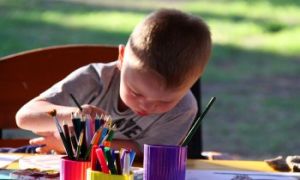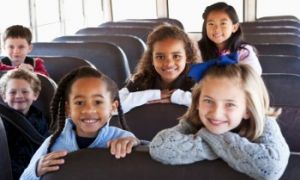Loose parts is a term used in early childhood learning to include such objects and materials that kids can move, control and change in numerous ways. Loose parts provided an opportunity for children to express creativity through the use of materials that can be manipulated, transformed, and created through self-guided play. The following article provides information of Examples of Loose Parts, The Benefits of Loose Parts, Links To Theorists and The EYLF, Loose Parts Activity Ideas and more.
What Are Loose Parts?
The term, ‘Loose parts’ was coined by architect Simon Nicholson, who believed in designing landscapes and environments that form connections. According to Nicholson, all human beings are born with creativity but which need to be empowered with certain environmental aspects – one of which is “loose parts”. He defined the term as “materials that are variable, meaning they can be used in more than one way so that children can then experiment and invent through play”. Over time, play experts and early childhood educators adapted the theory of loose parts, seeing in it a powerful tool to nurture not only creativity and imagination but also cognitive, sensory and physical learning.
Loose Parts Examples
In a natural play area – water, sand, dirt, sticks, branches, logs, driftwood, grass, moss, leaves, flowers, pinecones, pine needles, seeds, shells, bark, feathers, boulders, rocks, pebbles, stones
In a playground – balls, hoops, jump ropes, tires, sand, water, dirt, straw, boulders, rocks, stones, pebbles, buckets, cups, containers, digging tools, chalk, scarves, ribbons, fabric
In an indoor environment – blocks, building materials, measuring and pouring devices like cups, spoons, buckets, funnels, dramatic play props like scarves, ribbons, feathers, play cars, animals, and people, blankets, floor samples, sensory materials, recycled materials like paper tubes, papers, ribbons, caps, lids, wood scraps, wire, foam, cardboard, plastic gutters, small plungers, art materials like buttons, spools, natural and coloured popsicle sticks, beads, straws, paints, brushes.
Properties of Loose Parts Objects
From the above examples, some essential properties of loose parts can be summed up:
- They are portable. Loose parts are materials that can be moved, carried, combined, redesigned, lined up, and taken apart put back together in multiple ways.
- They are unstructured which means that their uses are not predetermined; there are no set of specific directions for materials that are considered loose parts.
- They are open-ended which means they can be used in various, multiple ways; thus a pinecone can be used as building component, as a prop in dramatic play or a spinning top.
- They are sensory. They engage the senses of sight, touch, sound, smell and even taste as children touch, roll, crush them, put in their mouth or bang them together to see what happens.
- They tend to be simple, easily found in a home and the outdoors; to some people, they might even seem ‘junk’ as they can be found in recycling bins, charity and craft stores.
- They can be used alone or combined with other materials – for example a child can use a stick to throw and catch or use it with rocks, stones and sand to build a bridge for toy soldiers.
Benefits Of Loose Parts Play
Many of the properties of loose parts are directly linked to the benefits that they offer to children during play.
- Autonomy – Loose parts play helps children develop a sense of independence as they have the freedom to explore different materials autonomously.
- Open-ended experiences - The greatest benefit in using loose parts to inspire play lies in its sheer variability. Kids quickly get bored of objects that come with a single purpose. So once they know that pushing the button to make a figure pop up or the jigsaw pieces can be fitted together to make just one picture, they want to try something different. Loose parts on the other hand offer learners infinite possibilities for play as they line up, scatter, carry, knock about, take apart, put together and redesign these parts. Educators can support children by providing easy access to variety of loose parts ranging from boxes and blocks to beads, sticks, ribbons, stones and rings among others.
- Sensory learning - The more children use all their senses early in their lives, the more their brains build neural pathways and synapses, leading to better cognitive skills in later life. A great way to engage all the senses in your young learners is through play with loose parts. Educators can keep a variety of materials like wood, yarn, clay, fabric, cardboard, sponge within easy reach for the them to pick and play with. Also include materials from nature like water, sand, mulch, dried leaves, mud, berries for children to explore colours, shapes and textures.
- Movement – the portable and piecemeal nature of loose parts means that children are bound to move and use their limbs as they get up, carry things around and manipulate the objects. Eductors can help the process further by supplying children with scarves, hoops, and ribbons that they can twirl, wave, flutter even as their limbs and gross motor skills get a thorough workout.
- Easily accessible - The other great advantage of using loose parts to plan playtime activities is they are affordable. Instead of buying expensive equipment from stores, one only need rummage through homes and centres to come up with small boxes, jar lids, buttons and colourful cups to facilitate loose parts play.
- Highly creative - Since loose parts do not come with how-to instructions, they offer ample opportunities for children to use their own imagination. Whether alone or combined with other materials, such objects can take up whatever role the player assigns to them. For example, a stick can be used as a magic wand, a fishing rod, a spoon for stirring a stew or a bridge across a puddle for caterpillars. This trait of loose parts enables children to create their own stories, experiment with roles, don multiple perspectives and push boundaries of the possible.
- Developmentally appropriate – the other advantage of the open-ended nature of loose parts is that children will use them in ways that suit their development level; this means that apart from keeping away choking hazards educators are freed from compulsions to grade the loose parts according to the skills and competencies of children.
- Aid in learning – there are innumerable ways that loose parts can be used to aid learning:
- loose parts like blocks, pebbles and bottle caps make for highly engaging sorting, classifying, combining and separating activities which are all ways to introduce numeracy.
- When children are encouraged to describe the various physical properties of loose parts (colour, texture, weight, shape, noises they make, how they smell etc) in front of them or what they have created with those parts, they get opportunities to build language and expand vocabulary. Similarly moving around and manipulating loose parts are great ways to practice position language.
- By virtue of their portable and open-ended nature, loose parts are especially great to experiment with. As children find out which items float or sink in water, what happens if they try to put a large block on top of a smaller one or what shadows do different loose parts cast, educators can use these experiences as provocations to discuss various concepts in science.
- Loose parts make for great props in expressive arts like drama and dance. Children find it great fun to use scarves, strings and empty boxes as props during storytelling or playacting. Also loose parts can be used as tools to create that art, for example a leaf can be dipped in paint and pressed onto a page or a feather can be used as a paintbrush.
Linking Early Childhood Theorists To Loose Parts
Rudolf Steiner’s (1861-1925) approach is based on providing children with suitable environments, with lots of natural resources and sensory experiences. In Steiner settings, there is usually no plastic, brightly coloured toys or resources but rather natural resources such as wood, sheep fleeces and beeswax crayons. The resources are chosen because they can be used in a variety of ways, just like loose parts and so are encouraging exploration and discovery
Lev Vygotsky (1896-1934) believed that educators and other children could use ‘scaffolding’ to build on the child’s current knowledge. This means helping them with open-ended questions and resources to get to the next piece of knowledge, as they are ready for it. Loose parts play allows children to scaffold such learning and skills. For example, to reach the stage where they can hold a pencil to start writing or pick up a pair of scissors to cut, children first need to start by picking up small objects. And loose parts play with beads, a stick or other materials, can help this happen.
The focus on the environment is so great in the Reggio Emilia approach that it is referred to as the “third teacher”. Such an environment uses open-ended materials that facilitate child-centred, creative play as well as materials from Nature – both of which incorporate loose parts like feathers, sea shells, cork, nuts and bolts, cardboard boxes, pebbles, beans, leaves, sticks, bark and flowers.
Sourcing Loose Parts
- Involve families in sourcing loose parts; they can easily collect common household items such as egg cartons, bottle caps, milk carton lids, paper towel and toilet paper tubes; display a list of resources so that they know what to look for.
- Scope out businesses like supermarkets or general stores that are willing to donate pipe cleaners, beads, buttons, sequins, cotton reels, paddle pop sticks and feathers that can be used as craft items.
- Furniture shops can be encouraged to contribute wooden items such as wood scraps or wooden blocks while recycling units can supply paper tubes, wire, foam, and cardboard boxes.
Organising Loose Parts
One of the challenges of loose parts play is that classrooms may look ‘untidy’. However, there are many ways of organising loose parts like:
- storing loose parts in buckets, basket or small containers that can also double as loose parts.
- Sorting the loose parts resources into categories like the colour, season, or even theme like tropical forests or tea parties.
- Using natural materials to border loose parts play space; for example making a border with pebbles or popsicle sticks can be a great way to designate a loose part play are and keeping such materials “contained”.
Loose Parts Play Activity Ideas
- Create prop boxes around interesting topics for indoor and outdoor use. Also known as ‘concept’ boxes, these can include materials related to interesting topics for indoor and outdoor use. For example, a Windy Day box can include streamers, Kites, Windmills, Bags, scarves, capes, paper yachts and wind chimes while a Sunny Day box can be stocked with Sun hats/caps, empty bottles for pretend sunscreens, sunglasses, small umbrellas and chalk to draw around shadows.
- Discovery-themed props may include gift boxes, containers, buckets, old handbags, and mirrors so children can see themselves from other angles and perspectives.
- Movement-based loose parts play can be facilitated by providing balls of different sizes, pipes, tubes, scarves, and beanbags. Throwing and dropping such objects will allow children to explore gravity, speed, pendulum motion and trajectories, and other forms of motion.
- Sensory-based loose parts play can be set up by allowing children to touch, feel and smell with:
- Fabrics, papers, leaves, plants, timbers and different textures
- Sand, dirt, flour, and water both inside and outdoors
- Scented play dough, mint and herbs
- Paint, water play, sand and dirt experiences
- Music-themed play can be encouraged by using everyday items, percussion and wind instruments including:
- Pots and pans
- Shakers made from bottles
- Wind chimes
- Pipes from a variety of materials including copper, PVC, bamboo
- Metal bowls and old utensils and cutlery
- Construction activities can be planned with:
- Blocks, Lego, mobile, Meccano
- Recycled materials
- Paper mache, clay, wire
- Plaster, timber, bricks
How To Facilitate Loose Parts Play
- Rotate loose parts in their containers over regular periods to allow children maximum opportunities to explore their physical properties, like weight, size, shape, texture, sand, smell.
- See that children can easily access and transport loose parts; the latter can be achieved by providing containers that can be repurposed as loose parts themselves, like baskets, small buckets, crates and mini-wheelbarrows.
- There should be enough materials and containers for a number of children play individually and if you find some objects are especially popular, ensure there are enough duplicates to reduce frustration and waiting time.
- Since play with loose parts requires higher degree of imagination, planning and analysis as compared to structured toys, ensure that children have ample space, time and a relaxed atmosphere to fully focus.
- Intervene into children’s play only when invited or you observe that a child requires guidance with a supporting skill – for example, rather than telling a child how to paint with leaves, show the child how to dip the leaf in paint and then let them take over.
EYLF Link To Loose Parts Play
Such are the attributes of loose parts play that it can be used to meet all five of the learning outcomes in the Early Years Learning Framework.
Outcome 1: Children have a strong sense of identity.
The open-ended nature of loose parts play allows children to express their individuality and agency. It is not unusual to find that two kids presented with the same collection of loose parts end up creating two completely different things. Neither is right or wrong and both are free to use loose parts to give expression to their own identity. Educators can further support the process by providing them with a safe and nurturing environment so that they are free to explore and express themselves.
Outcome 2: Children are connected with and contribute to their world.
Items found in nature make up some of the most attractive loose parts collections for young children. As they play with these, they develop connections with their natural world which can be deepened to nurture a sense of responsibility for the environment and community.
Outcome 3: Children have a strong sense of wellbeing
As children use their fingers, hands and legs to pick up, sort and carry loose parts, they develop important muscles and motor skills. Also types of loose parts play like decorating with flower, dressing up in scarves and feathers or digging fingers into bean bins are all examples of satisfying emotional experiences.
Outcome 4: Children are confident Learners
Different ways that loose parts can be used in language, mathematics, arts and scientific learning has already been discussed. Yet another benefit of loose parts play is that it makes room for the learning preferences of each child. As children learn in a way that suits their personality and interests, they are motivated to ask questions, offer insights, thereby developing confidence.
Outcome 5: Children are effective Communicators
When children play with loose parts, they get opportunities to explain their observations, sensory experiences and creations, thereby practising communication skills. Also, loose parts play lends itself to many types of group play, thereby encouraging children to learn and practise social skills like turn-taking, negotiation and collaboration.
Challenges Of Loose Parts Play
Despite so many advantages of loose parts play, at times it may be challenging to put it into practice for the following reasons:
- Safety issues – loose parts can be dangerous because of their small size and thus constitute a choking hazard for young children. Also, some natural materials like plant parts can be toxic. In order to avoid such hazards, be sure to screen natural materials and loose parts before allowing children access. Ensure items are safe to be explored by the mouth. Look for sharp edges or possibilities for a part to break off. Ensure items are of a safe size to prevent choking.
- Educator expertise – to help children get the maximum learning benefits of loose part play, it is important for educators to observe without directing but offer support at the right moments. They need to watch and wait for play cues which is a hint or an invitation from the child to join in and play. Children communicate these invitations to play in different ways, sometimes verbally but more often through gestures, posture or expressions, like making a funny face at someone, allocating roles like ‘you can be the giant’, throwing a ball at someone and so on. All this can be challenging for less experienced or less trained educators to spot and identify, thereby missing out on the learning potentialities of loose parts play. Nevertheless, there are many resources from authentic sources that can help educators to understand children’s play by looking out for play cues and respond appropriately.
Loose Parts off learners infinite possibilities for play as they line up, scatter, carry, knock about, take apart, put together and redesign these parts. As an educator, you can support your learners by providing easy access to a variety of loose parts ranging from boxes and blocks to beads, sticks, ribbons, stones and rings among others.
References:
- Nicholson, S. (1971). How not to cheat children – The theory of loose parts. Landscape Architecture, 62, 30-34.
- Family Day Care Loose Parts, SA Departement Of Education
- Loose Parts Play, Gowrie NSW
- Loose Parts What Does This Mean, PSU







 As an Educator in Australia, your pay rate falls under the Children’s Services Award 2010. This award states the minimum amount that an employer can
As an Educator in Australia, your pay rate falls under the Children’s Services Award 2010. This award states the minimum amount that an employer can When working as a qualified Early Childhood Teacher (with a university degree) within a service, your rate of pay will come from the Educational Services
When working as a qualified Early Childhood Teacher (with a university degree) within a service, your rate of pay will come from the Educational Services When working as a Diploma Qualified Educator your pay rate is from the Children's Services Award 2010. This Award states your minimum rate of pay
When working as a Diploma Qualified Educator your pay rate is from the Children's Services Award 2010. This Award states your minimum rate of pay When working as a Cert 3 Qualified Educator, your pay rate is from the Children's Services Award 2010. This Award states your minimum rate of
When working as a Cert 3 Qualified Educator, your pay rate is from the Children's Services Award 2010. This Award states your minimum rate of Educational Leaders play a crucial role in their early childhood service by ensuring that the educational program aligns with best practices and supports the holistic
Educational Leaders play a crucial role in their early childhood service by ensuring that the educational program aligns with best practices and supports the holistic In early childhood education and care, ratios are more than a technicality—they are a frontline safeguard. Every child deserves responsive supervision, emotional connection, and developmental
In early childhood education and care, ratios are more than a technicality—they are a frontline safeguard. Every child deserves responsive supervision, emotional connection, and developmental With the new national child safety reforms kicking in on 1 September 2025, early childhood services like yours have a real opportunity to lead the
With the new national child safety reforms kicking in on 1 September 2025, early childhood services like yours have a real opportunity to lead the Here’s a comprehensive Mobile Phone and Smart Watch Policy tailored for early childhood education and care (ECEC) services in Australia, aligned with the latest 2025
Here’s a comprehensive Mobile Phone and Smart Watch Policy tailored for early childhood education and care (ECEC) services in Australia, aligned with the latest 2025 The Sea of Fish Challenge is a national initiative that invites children, educators, families, and communities to create and display fish artworks as a symbol
The Sea of Fish Challenge is a national initiative that invites children, educators, families, and communities to create and display fish artworks as a symbol Across the early childhood education and care sector, educators are sounding the alarm: current staffing ratios are insufficient to deliver safe, meaningful, and developmentally appropriate
Across the early childhood education and care sector, educators are sounding the alarm: current staffing ratios are insufficient to deliver safe, meaningful, and developmentally appropriate


